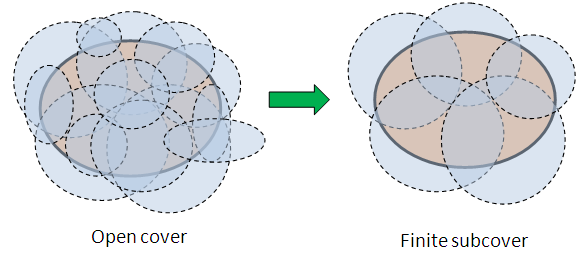ជំពូក៥ : លំហកុំប៉ាក់
October 2nd, 2020
From Wikipedia:
Per the compactness criteria for Euclidean space as stated in the Heine–Borel theorem, the interval $A = (-\infty, -2]$ is not compact because it is not bounded. The interval $C = (2, 4)$ is not compact because it is not closed. The interval $B = [0, 1]$ is compact because it is both closed and bounded.
In mathematics, specifically general topology, compactness is a property that seeks to generalize the notion of a closed and bounded subset of Euclidean space[1] by making precise the idea of a space having no "holes" or "missing endpoints", i.e. that the space not exclude any "limiting values" of points. For example, the "unclosed" interval $(0,1)$ would not be compact because it excludes the "limiting values" of $0$ and $1$, whereas the closed interval $[0,1]$ would be compact.
Similarly, the space of rational numbers $\mathbb {Q}$ is not compact because it has infinitely many "holes" corresponding to the irrational numbers, and the space of real numbers $\mathbb {R}$ is not compact either because it excludes the limiting values $\infty$ and $-\infty$ . However, the extended real number line would be compact, since it contains both infinities. There are many ways to make this heuristic notion precise. These ways usually agree in Euclidean space, but may be inequivalent in other topological spaces.
Covers of Sets in a Topological Space
The term “cover” is used here to denote an “open cover” when the context is clear and no ambiguity can arise.
Let $X$ be a topological space and let $A \subseteq X$. Then a Cover/Covering of $A$ is a collection of subsets $\mathcal{F}=\{U_i: i\in I\}$ of $X$ such that $$A \subseteq \bigcup_{i\in I} U_i$$
- If $\mathcal{F}$ is a collection of open sets that satisfies the above inclusion then $\mathcal{F}$ is called an Open Cover/Covering of $A$.
- Similarly, if $\mathcal{F}$ is a collection of closed sets that satisfies the above inclusion then $\mathcal{F}$ is called a Closed Cover/Covering of $A$.
- If $\mathcal{F}^{*} \subseteq \mathcal{F}$ also covers $A$ then we said that $\mathcal{F}^{*} = \{U_{\lambda} : \lambda \in J\subset I\}$ is a Subcover of $A$ from $\mathcal{F}$.
- Consider the topological space $\mathbb{R}$ with the usual topology. Let the set $A=\mathbb{N} \subset \mathbb{R}$. Every singleton set in $\mathbb{R}$ is closed and so the collection $\mathcal F = \{\{n\}: n \in \mathbb{N}\}$ is a closed covering of $\mathbb{N}$ since (WHY?):
- Let see the collection $\mathcal F=\left\{\left(n-\frac{1}{2}, n+\frac{1}{2}\right): n \in \mathbb{N}\right\}$ is an open covering of $\mathbb{N}$. (WHY?)
- For another example, consider the set $A=[0,1) \subset \mathbb{R}$. Then the collection $\mathcal{F}=\left\{\left(-1, \frac{2}{3}\right),\left(\frac{1}{2}, 2\right)\right\}$ is an open cover of $[0,1)$. In general, many open covers for subsets of a topological space may exist.
RECALL: (Topological Subspaces). Given the Topological Subspaces $(X, \tau)$ and $A \subseteq X$ then the subspace topology on $A$ is defined to be: $$ \tau_{A}=\{A \cap U: U \in \tau\} $$ We verified that $\tau_{A}$ is indeed a topology for any subset $A$ of $X$. (Can you proof this?)
Consider the topological space $(\mathbb{R}, \tau)$ where $\tau$ is the usual topology of open intervals in $\mathbb{R}$. Verify that the subspace topology on $\mathbb{Z} \subseteq \mathbb{R}$ is the discrete topology on $\mathbb{Z}$. (WHY?)
Let $X$ be a topological space and let $A \subseteq X$. Then $A$ is said to be Compact in $X$ if every open covering of $A$ (from $X$ ) has a finite open subcover.

READ!.. Please always remember that every closed and bounded interval $[a, b] \subset \mathbb{R}$ (where $\mathbb{R}$ has the usual topology) is compact. In fact, a set $A \subset \mathbb{R}$ is compact if and only if $A$ is both closed and bounded.
More generally, if $\mathbb{R}^{n}$ has the usual topology then $A \subseteq \mathbb{R}^{n}$ is compact if and only if $A$ is both closed and bounded.
In general, it's rather difficult to show that a set is compact and it is usually easier to show that a set is not compact.
consider the set of natural numbers $\mathbb{N} \subset \mathbb{R}$. We claim that $\mathbb{N}$ is not compact in $\mathbb{R}$. To show this, consider the following open cover of $\mathbb{N}$ : $$ \mathcal{F}=\left\{\left(n-\frac{1}{2}, n+\frac{1}{2}\right): n \in \mathbb{N}\right\} $$ (PLEASE EXPLAIN IT!)
Let $X$ be any topological space. If $A \subseteq X$ is a finite set then $A$ is compact in $X$.
If $X$ is a finite topological space then every subset $A \subseteq X$ is compact in $X$.
Proof: Every subset $A$ of a finite set $X$ is finite. So by Theorem (1) $A$ is compact in $X$.
Let $\mathcal{F}$ be a collection of sets. Then $\mathcal{F}$ is said to have the Finite Intersection Property (FIP) if for every finite collection of sets from $\mathcal{F}$, which is $\left\{F_{1}, F_{2}, \ldots, F_{n}\right\} \subseteq \mathcal{F}$, we have that $$\bigcap_{i=1}^{n} F_{i} \neq \varnothing$$
Let $X$ be a topological space. Then $X$ is compact if and only if for every collection of closed sets $\mathcal{F}$ from $X$, we have that \[ \text{ If \;} \mathcal{F} \text{\; has the finite intersection property, then \;\;} \bigcap_{F \in \mathcal{F}} F \neq \varnothing\]
Preservation of Compactness under Continuous Maps
We will see in the following theorem, compactness is preserved under continuous maps, i.e., if $X$ and $Y$ are topological spaces, and $A \subseteq X$ is compact in $X$, and $f: A \rightarrow Y$ is a continuous map, then the image $f(A)$ will also be compact in $Y$.
Let $X$ and $Y$ be topological spaces, $A \subseteq X$, and $f: A \rightarrow Y$ be a continuous map. If $A$ is compact in $X$ then $f(A)$ is compact in $Y$.
Recent Posts
- A Note on the Variation of Parameters Method | 11/01/17
- Group Theory, Part 3: Direct and Semidirect Products | 10/26/17
- Galois Theory, Part 1: The Fundamental Theorem of Galois Theory | 10/19/17
- Field Theory, Part 2: Splitting Fields; Algebraic Closure | 10/19/17
- Field Theory, Part 1: Basic Theory and Algebraic Extensions | 10/18/17